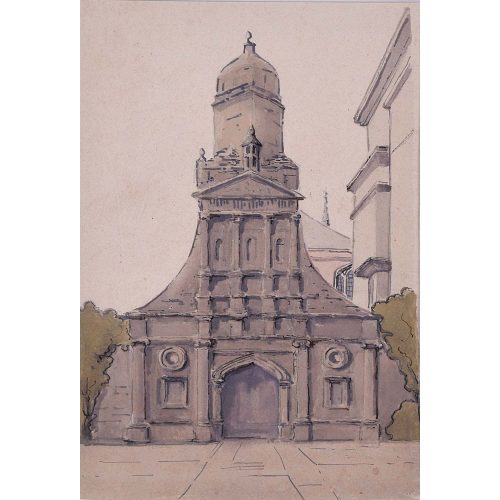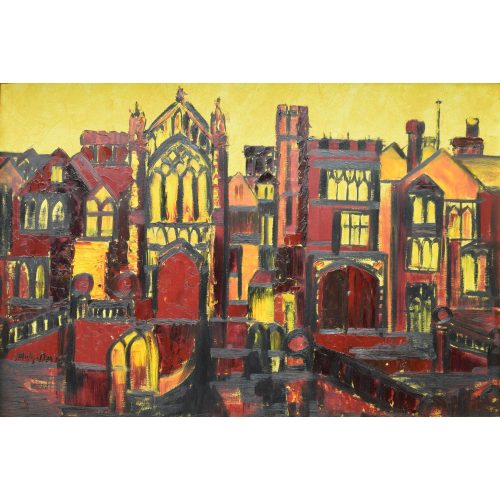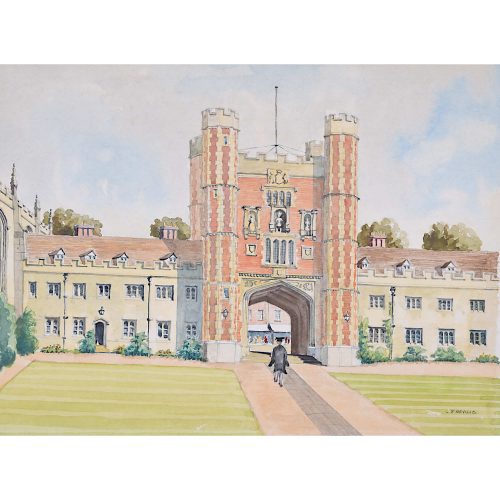-
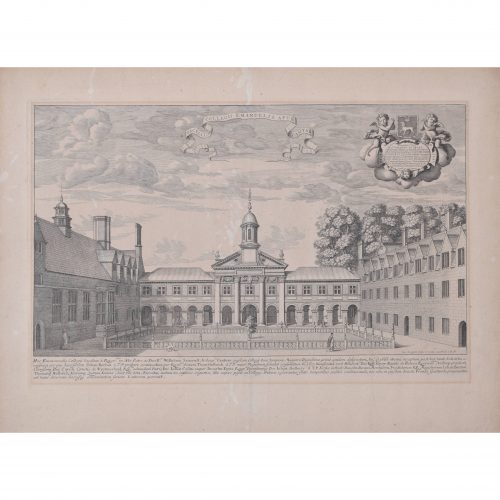
David Loggan (1634 - 1692)
Emmanuel College, Cambridge (1690)
Engraving 31 x 47 cm Loggan was born to English and Scottish parents, and was baptised in Danzig in 1634. After studying engraving in Danzig with Willem Hondius (1598-1652 or 1658), he moved to London in the late 1650s, going on to produce the engraved title-page for the folio 1662 Book of Common Prayer. He married in 1663 and moved to Nuffield in Oxfordshire in 1665. Loggan was appointed Public Sculptor to the nearby University of Oxford in the late 1660s, having been commissioned to produce bird’s-eye views of all the Oxford colleges. He lived in Holywell Street as he did this. The 'Oxonia Illustrata' was published in 1675, with the help of Robert White (1645 - 1704). Following its completion, Loggan began work on his equivalent work for Cambridge; the 'Cantabrigia Illustrata' was finally published in 1690, when he was made engraver to Cambridge University. The 'Oxonia Illustrata' also includes an engraving of Winchester College (Winchester and New College share William of Wykeham as their founder) whilst the 'Cantabrigia Illustrata' includes one of Eton College (which shares its founder, Henry VIII, with King’s College). Bird’s-eye views from this era required a particular talent as an architectural perspectivist; it was not until 1783 that it became possible for artists to ascend via hot air balloons and view the scenes they were depicting from above. Loggan thus had to rely on his imagination in conceiving the views. Loggan’s views constitute the first accurate depictions of the two Universities, in many ways unchanged today. Whilst the Oxford engravings were produced in reasonable numbers and ran to a second edition by Henry Overton (on thicker paper and with a plate number in Roman numerals in the bottom right-hand corner), those of Cambridge were printed in much smaller numbers. The Dutchman Pieter van der Aa published some miniature versions of the engravings for James Beverell’s guidebook to the UK, 'Les Delices de la Grande Bretagne' (circa 1708). The contemporary artist Andrew Ingamells has produced a highly-acclaimed series of etchings which bring Loggan’s original vision up to date. Condition: generally very good; mostly even all-over toning. If you’d like to know more, please email info@manningfineart.co.uk or call us on 07929 749056. -
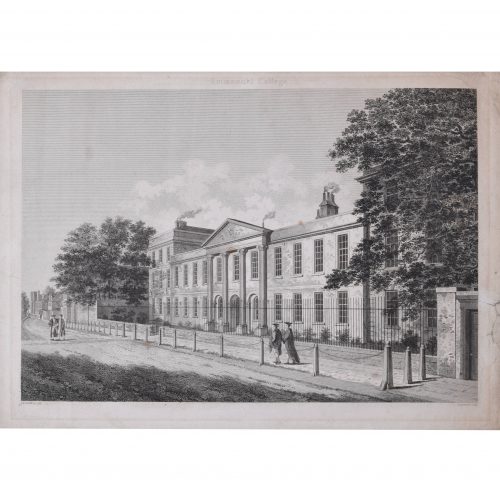
Samuel Sparrow (active 1800) after John Kirby Baldrey (1750 - 1823)
Emmanuel College, Cambridge
Engraving 35 x 49 cm An engraving of Emmanuel College's neoclassical facade, complete with strolling undergraduates in pairs. The engraving was printed in the Cambridge Almanack in 1806. Samuel Sparrow was a British engraver of landscapes and architectural scenes after his fellow artists, often published as bookplates. John Kirkby Baldrey was a draughtsman and engraver who provided designs for the Cambridge University Almanack between 1803 and 1810. Condition: generally very good; some age toning. If you’d like to know more, please email info@manningfineart.co.uk or call us on 07929 749056. -

Walter Hoyle (1922 - 2000)
Emmanuel College, Cambridge (Cambridge Series 1956 - 66)
Linocut 55 x 43 cm Signed and inscribed A/P in pencil. Hoyle's view of Emmanuel's Front Court bleaches the gold of the chapel's Ketton Stone into an icy blue, and situates it beneath a tempestuous yellow sky. Hoyle trained at Beckenham School of Art and the Royal College of Art. At the latter he was strongly influenced by Edward Bawden, one of Britain’s greatest linocut printers. Bawden had been commissioned by the 1951 Festival of Britain to produce a mural for the South Bank, and chose Hoyle to assist on account of his great talent. Hoyle moved to Great Bardfield in Essex, becoming a part of the Great Bardfield group of artists; diverse in style, they created figurative work, in stark contrast to the abstract art of the St Ives artists at the opposite end of the country. Hoyle taught at St Martin’s School of Art from 1951-60, the Central School of Arts and Crafts from 1960-64, and the Cambridge School of Art from 1964-1985, during which time he launched Cambridge Print Editions. His work is held in the collections of the Tate Gallery, the Victoria and Albert Museum, The British Museum, Kettle’s Garden and the Fry Art Gallery. Provenance: family of the artist. Condition: generally very good; a few handling marks and areas of discolouration to extreme margins, extraneous ink to right hand side, and a very small brown spot to very top right beyond the blue sky. If you are interested, please email info@manningfineart.co.uk or call us on 07929 749056. Click here for other views of Emmanuel College, Cambridge. -
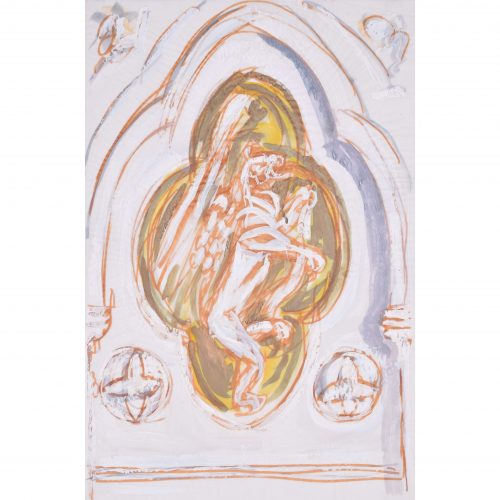
Margaret Souttar (1914 - 1987)
Emmanuel College, Cambridge Lion Rampant (1960)
Acrylic paint 74 x 50 cm Signed and dated lower right. Souttar was a Scottish painter and printmaker known for her images of town- and cityscapes. In the early 1960s, she was commissioned to produce a series of prints of the Cambridge colleges. She captures the modernity and optimism of 1960s Cambridge; the fact that a female artist was commissioned to create the prints reflects the changing attitudes of the University towards women. These views highlight the layers of history and architectural styles which make up a Cambridge college. Provenance: the artist's studio sale. Condition: generally very good; some crinkling as a result of using water-based paints on thin paper. If you are interested, please email info@manningfineart.co.uk or call us on 07929 749056. Click here for other views of Emmanuel College, Cambridge. -
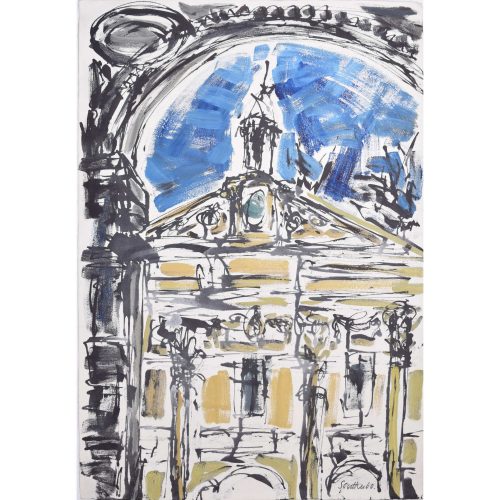
Margaret Souttar (1914 - 1987)
Emmanuel College, Cambridge (1960)
Acrylic paint 102 x 69 cm Signed and dated lower right. Souttar was a Scottish painter and printmaker known for her images of town- and cityscapes. In the early 1960s, she was commissioned to produce a series of prints of the Cambridge colleges. She captures the modernity and optimism of 1960s Cambridge; the fact that a female artist was commissioned to create the prints reflects the changing attitudes of the University towards women. These views highlight the layers of history and architectural styles which make up a Cambridge college. Provenance: the artist's studio sale. Condition: generally very good. If you are interested, please email info@manningfineart.co.uk or call us on 07929 749056. Click here for other views of Emmanuel College, Cambridge. -
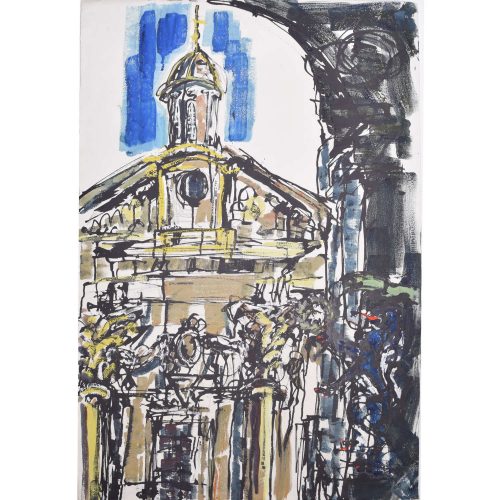
Margaret Souttar (1914 - 1987)
Emmanuel College, Cambridge with Lion Rampant (1960)
Acrylic paint 102 x 69 cm Signed and dated lower right. Souttar was a Scottish painter and printmaker known for her images of town- and cityscapes. In the early 1960s, she was commissioned to produce a series of prints of the Cambridge colleges. She captures the modernity and optimism of 1960s Cambridge; the fact that a female artist was commissioned to create the prints reflects the changing attitudes of the University towards women. These views highlight the layers of history and architectural styles which make up a Cambridge college. Provenance: the artist's studio sale. Condition: generally very good. If you are interested, please email info@manningfineart.co.uk or call us on 07929 749056. Click here for other views of Emmanuel College, Cambridge. -
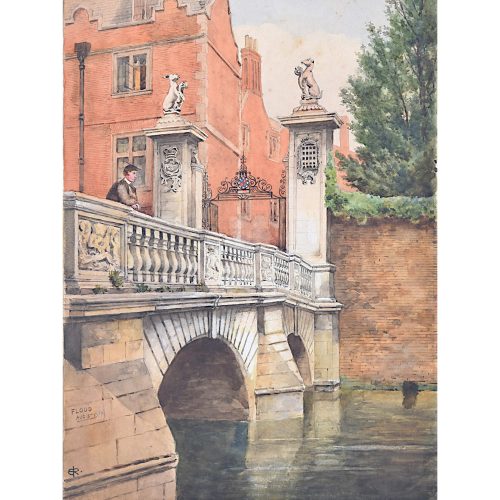
'ER' Monogrammist St John's College Cambridge, the Wren Bridge from the River Cam
Watercolour c. 1900 35x25cm A highly accomplished watercolour of the Kitchen Bridge at St John's College. The artist has clearly had a change of heart, and visibly moved the person standing on the bridge, bringing a sense of movement to what is otherwise a still painting. Moreover the richness of the colour he has chosen for the brickwork brings a further element of surprise to the viewer. If you are interested email info@manningfineart.co.uk or call us on 07929 749056. Condition: Mounted to board, the occasional tiny spot to the sky as visible in photograph. -
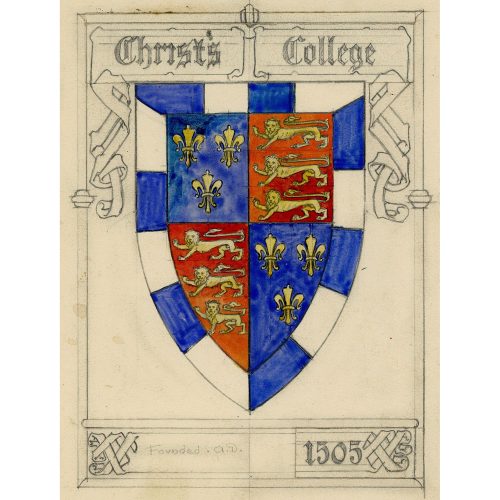
Florence Camm (1874-1960)
Christ's College Cambridge Crest
Pencil and watercolour 15x11cm Design for TW Camm & Co. If you are interested email info@manningfineart.co.uk or call us on 07929 749056. -
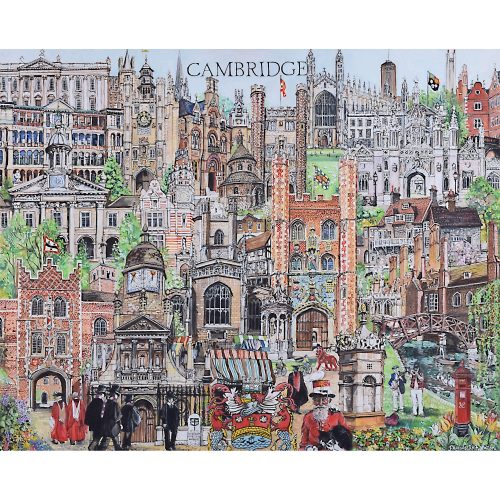
Francess Richardson
Cambridge Capriccio
Gouache on paper c. 1980 43x53cm Framed in hand-finished black frame A Cambridge-based artist who has accumulated all the best features of Cambridge in this one drawing. Originally from Rochdale, she has lived near Cambridge since the mid 1970s. If you are interested email info@manningfineart.co.uk or call us on 07929 749056. -
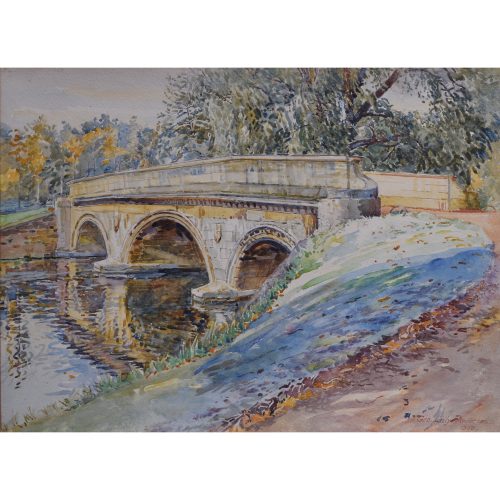
George Lilly Anderson (British b. 1870)
Trinity College Cambridge Bridge
28x38cm Watercolour Intriguingly nothing is known of Anderson's life, apart from the carefully painted landscapes. If you are interested email info@manningfineart.co.uk or call us on 07929 749056. -

George Pyne (1800-1884)
Great Court, Trinity College, Cambridge
Signed G Pyne 1850 Watercolour 20.5 x 29 cm (8 x 11.5 in.) It appears Pyne spent some time painting in Cambridge in 1849-50. This is - for Pyne - an unusually large composition; a fine watercolour of Trinity Great Court, with King’s College chapel in the background and elegant figures in the court. It is a particularly pleasing composition. Click here for biographical details and other works by the artist. If you are interested email info@manningfineart.co.uk or call us on 07929 749056. -
Out of stock

Hugh Casson (1910 - 1999)
The Gatehouse, Girton College
Lithograph 31 x 26 cm Signed and numbered 161/500, both in pencil. Casson's warm-hued view of Girton, with students strolling under the the neo-Tudor gatehouse. Sir Hugh Casson was educated at Eastbourne College; St John’s College, Cambridge; and the Bartlett School of Architecture. Trained in the 1930s in the early modernist style, he taught at the Cambridge School of Architecture. After employment as a camoufleur during World War 2 by the Air Ministry, in 1948 he was appointed as director of architecture for the Festival of Britain. A close friend of the Royal Family, he undertook designs for the 1953 coronation, designed the interior of the Royal Yacht Britannia (“The overall idea was to give the impression of a country house at sea”), and taught the young Charles III to paint in watercolours. Amongst his architectural achievements are the Elephant House at London Zoo, the 1978 redevelopment of Bristol Docks, the Raised Faculty Building for The University of Cambridge, and a building for the Royal College of Art. He published a number of illustrated books, of which Casson’s Oxford and Casson’s Cambridge are probably the best known. A limited edition series of prints was produced from the paintings. Condition: generally very good. If you’d like to know more, please email info@manningfineart.co.uk or call us on 07929 749056. Click here for other views of Girton College, Cambridge. -
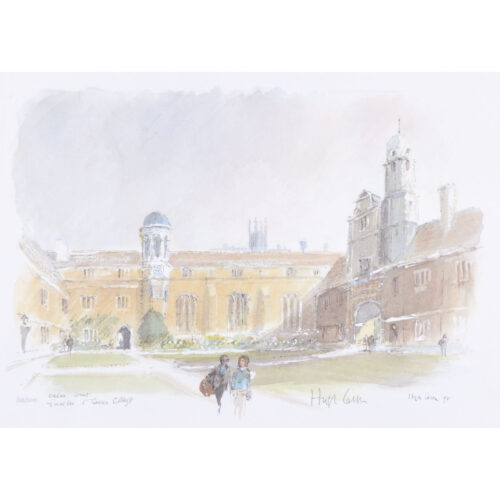
Hugh Casson (1910 - 1999)
Caius Court, Gonville and Caius College (1992)
Lithograph 31 x 44 cm Signed and numbered 358/500, both in pencil. Casson's depiction of Gonville and Caius, with sun slanting into the 16th-century Caius Court. Members of the college stroll through the court. Sir Hugh Casson was educated at Eastbourne College; St John’s College, Cambridge; and the Bartlett School of Architecture. Trained in the 1930s in the early modernist style, he taught at the Cambridge School of Architecture. After employment as a camoufleur during World War 2 by the Air Ministry, in 1948 he was appointed as director of architecture for the Festival of Britain. A close friend of the Royal Family, he undertook designs for the 1953 coronation, designed the interior of the Royal Yacht Britannia (“The overall idea was to give the impression of a country house at sea”), and taught the young Charles III to paint in watercolours. Amongst his architectural achievements are the Elephant House at London Zoo, the 1978 redevelopment of Bristol Docks, the Raised Faculty Building for The University of Cambridge, and a building for the Royal College of Art. He published a number of illustrated books, of which Casson’s Oxford and Casson’s Cambridge are probably the best known. A limited edition series of prints was produced from the paintings. Condition: very good. If you are interested, please email info@manningfineart.co.uk or call us on 07929 749056. Click here for other views of Gonville and Caius, Cambridge. -
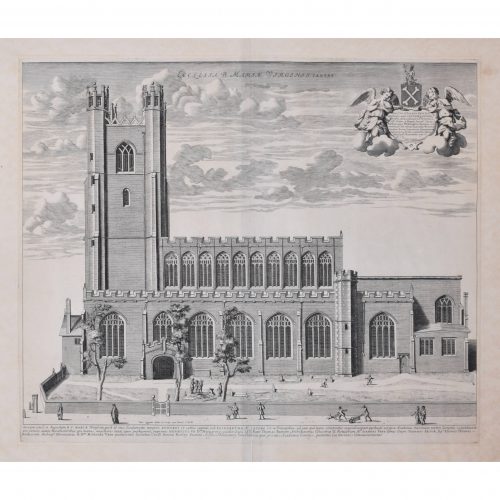
David Loggan (1634 - 1692)
The Church of St Mary the Virgin, Cambridge (1690)
Engraving 38 x 47 cm Loggan was born to English and Scottish parents, and was baptised in Danzig in 1634. After studying engraving in Danzig with Willem Hondius (1598-1652 or 1658), he moved to London in the late 1650s, going on to produce the engraved title-page for the folio 1662 Book of Common Prayer. He married in 1663 and moved to Nuffield in Oxfordshire in 1665. Loggan was appointed Public Sculptor to the nearby University of Oxford in the late 1660s, having been commissioned to produce bird’s-eye views of all the Oxford colleges. He lived in Holywell Street as he did this. The 'Oxonia Illustrata' was published in 1675, with the help of Robert White (1645 - 1704). Following its completion, Loggan began work on his equivalent work for Cambridge; the 'Cantabrigia Illustrata' was finally published in 1690, when he was made engraver to Cambridge University. The 'Oxonia Illustrata' also includes an engraving of Winchester College (Winchester and New College share William of Wykeham as their founder) whilst the 'Cantabrigia Illustrata' includes one of Eton College (which shares its founder, Henry VIII, with King’s College). Bird’s-eye views from this era required a particular talent as an architectural perspectivist; it was not until 1783 that it became possible for artists to ascend via hot air balloons and view the scenes they were depicting from above. Loggan thus had to rely on his imagination in conceiving the views. Loggan’s views constitute the first accurate depictions of the two Universities, in many ways unchanged today. Whilst the Oxford engravings were produced in reasonable numbers and ran to a second edition by Henry Overton (on thicker paper and with a plate number in Roman numerals in the bottom right-hand corner), those of Cambridge were printed in much smaller numbers. The Dutchman Pieter van der Aa published some miniature versions of the engravings for James Beverell’s guidebook to the UK, 'Les Delices de la Grande Bretagne' (circa 1708). The contemporary artist Andrew Ingamells has produced a highly-acclaimed series of etchings which bring Loggan’s original vision up to date. Condition: has been previously washed; generally good. If you’d like to know more, please email info@manningfineart.co.uk or call us on 07929 749056. -
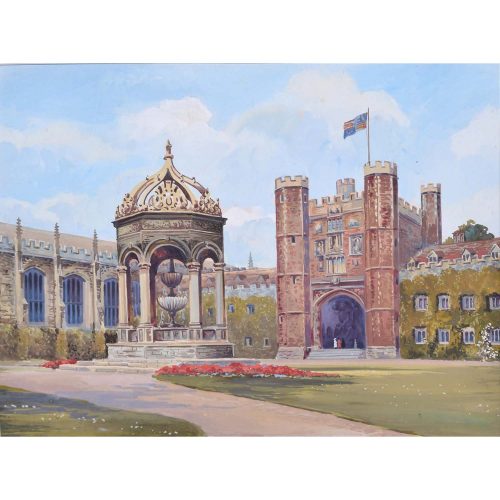
Gwen White
Great Court, Trinity College, Cambridge
Gouache 24x32cm Gwen White is author of Perspective: A Guide for Artists, Architects and Designers and this view of Trinity is painted with an architect’s eye for detail. If you are interested email info@manningfineart.co.ukor call us on 07929 749056. -

Hanslip Fletcher (1874-1955) St John's College, Cambridge
20x30cm Pen and Wash If you are interested email info@manningfineart.co.uk or call us on 07929 749056. Condition: Good. -
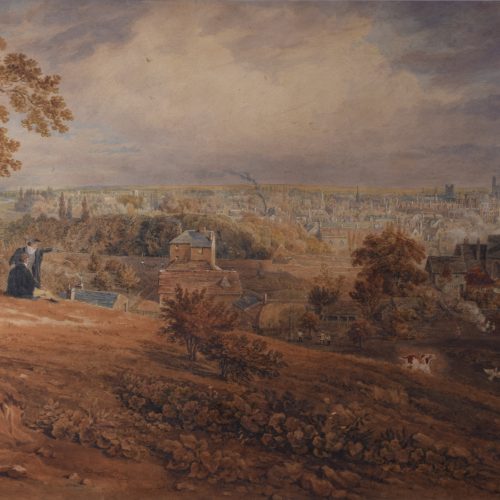
Henry Sargant Storer (1791-1837)
A view of Cambridge from Castle Hill c.1824
Watercolour 46x74.5cm Original watercolour for engraving published in c. 1824. We have a copy of the engraving available, please ask to see it! Provenance: from the family of the artist. A very large and very fine view of Cambridge from Castle Hill. New Court of St John's College shines brightly, being in the course of construction - it was finished in 1831. A later panorama of Cambridge in 1838 shows Jesus Green lock in the course of construction. If you are interested email info@manningfineart.co.uk or call us on 07929 749056. -
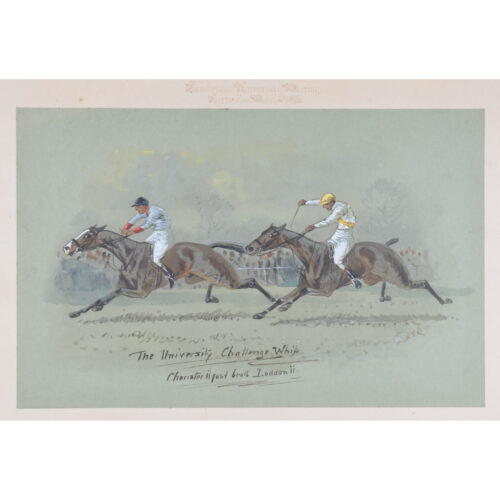
William Verner Longe (1857-1924)
The University Challenge Whip (1900)
Watercolour 29 x 45 cm Signed and inscribed "Choristor ii just beats Loddon ii". Inscribed 'Cambridge University Meeting, Cottenham, March 1909' to mount. A lively racing scene by William Verner Longe, and English artist noted for his scenes of racing, hunting, and other equestrian activities. He was educated at the Ipswich School of Arts and then the Royal Academy of Fine Arts in Antwerp. Condition: generally good; some spots to mount. If you are interested, please email info@manningfineart.co.uk or call us on 07929 749056. Click here for other Cambridge pictures. -
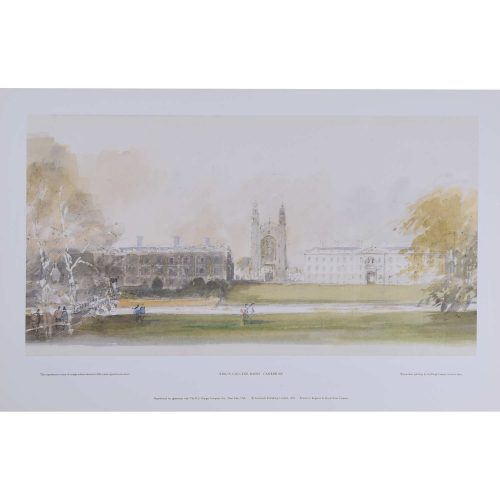 Sir Hugh Casson (1910-1999) King's College from the Backs 22 x 41cm Unsigned proof print Sir Hugh Casson was educated at Eastbourne College, St John’s College Cambridge and the Bartlett School of Architecture. Trained in the 1930s in the early modernist style, he taught at the Cambridge School of Architecture. After employment as a camoufleur during World War 2 by the Air Ministry, in 1948 he was appointed as director of architecture for the Festival of Britain. A close friend of the Royal Family, he undertook designs for the 1953 coronation, designed the interior of the Royal Yacht Britannia (“The overall idea was to give the impression of a country house at sea”), and taught the Prince of Wales to paint in watercolours. Amongst his architectural achievements are the Elephant House at London Zoo, the 1978 redevelopment of Bristol Docks, the Raised Faculty Building for The University of Cambridge, and a building for the Royal College of Art. He published a number of illustrated books, of which Casson’s Oxford and Casson’s Cambridge are probably the best known. A limited edition series of prints was produced from the paintings. King's College is a constituent college of the University of Cambridge in Cambridge, England. Formally The King's College of Our Lady and Saint Nicholas in Cambridge, the college lies beside the River Cam and faces out onto King's Parade in the centre of the city.
Sir Hugh Casson (1910-1999) King's College from the Backs 22 x 41cm Unsigned proof print Sir Hugh Casson was educated at Eastbourne College, St John’s College Cambridge and the Bartlett School of Architecture. Trained in the 1930s in the early modernist style, he taught at the Cambridge School of Architecture. After employment as a camoufleur during World War 2 by the Air Ministry, in 1948 he was appointed as director of architecture for the Festival of Britain. A close friend of the Royal Family, he undertook designs for the 1953 coronation, designed the interior of the Royal Yacht Britannia (“The overall idea was to give the impression of a country house at sea”), and taught the Prince of Wales to paint in watercolours. Amongst his architectural achievements are the Elephant House at London Zoo, the 1978 redevelopment of Bristol Docks, the Raised Faculty Building for The University of Cambridge, and a building for the Royal College of Art. He published a number of illustrated books, of which Casson’s Oxford and Casson’s Cambridge are probably the best known. A limited edition series of prints was produced from the paintings. King's College is a constituent college of the University of Cambridge in Cambridge, England. Formally The King's College of Our Lady and Saint Nicholas in Cambridge, the college lies beside the River Cam and faces out onto King's Parade in the centre of the city. -
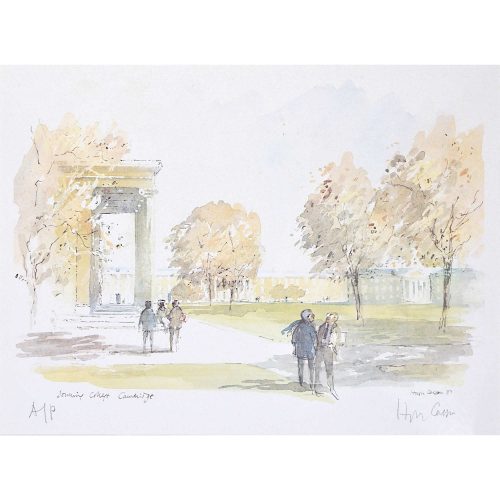
Hugh Casson (1910-1999)
Downing College Cambridge (1988)
Limited edition print signed in pencil and numbered 234/500 (N.B. another copy illustrated) 27x38cm From Casson’s ever-popular Cambridge series of prints. If you are interested email info@manningfineart.co.uk or call us on 07929 749056. For biographical details and other works by the artist click here. -
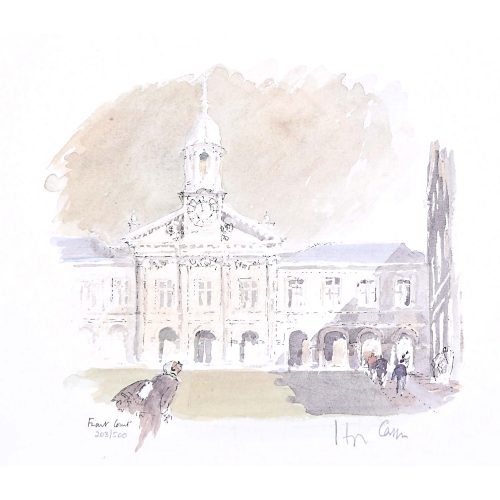
Hugh Casson (1910 - 1999) Emmanuel College Cambridge, Front Court
Signed in pencil, and numbered from the limited edition of 500. 24x27cm From Casson’s ever-popular Oxford and Cambridge series of prints. Sir Hugh Casson was educated at Eastbourne College, St John’s College Cambridge and the Bartlett School of Architecture. Trained in the 1930s in the early modernist style, he taught at the Cambridge School of Architecture. After employment as a camoufleur during World War 2 by the Air Ministry, in 1948 he was appointed as director of architecture for the Festival of Britain. A close friend of the Royal Family, he undertook designs for the 1953 coronation, designed the interior of the Royal Yacht Britannia (“The overall idea was to give the impression of a country house at sea”), and taught the Prince of Wales to paint in watercolours. Amongst his architectural achievements are the Elephant House at London Zoo, the 1978 redevelopment of Bristol Docks, the Raised Faculty Building for The University of Cambridge, and a building for the Royal College of Art. He published a number of illustrated books, of which Casson’s Oxford and Casson’s Cambridge are probably the best known. A limited edition series of prints was produced from the paintings. If you are interested email info@manningfineart.co.uk or call us on 07929 749056. Condition: Good, very slight age toning to visible area. -
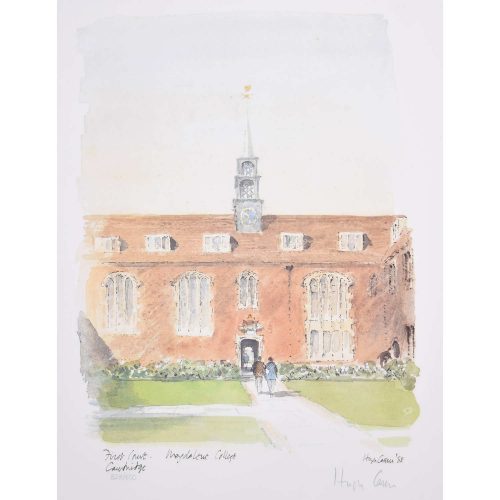
Hugh Casson (1910 - 1999)
Magdalene College, Cambridge, First Court
Signed in pencil, and numbered 328/500 from the limited edition of 500. 34x25cm From Casson’s ever-popular Oxford and Cambridge series of prints. Sir Hugh Casson was educated at Eastbourne College; St John’s College, Cambridge; and the Bartlett School of Architecture. Trained in the 1930s in the early modernist style, he taught at the Cambridge School of Architecture. After employment as a camoufleur during World War 2 by the Air Ministry, in 1948 he was appointed as director of architecture for the Festival of Britain. A close friend of the Royal Family, he undertook designs for the 1953 coronation, designed the interior of the Royal Yacht Britannia (“The overall idea was to give the impression of a country house at sea”), and taught the Prince of Wales to paint in watercolours. Amongst his architectural achievements are the Elephant House at London Zoo, the 1978 redevelopment of Bristol Docks, the Raised Faculty Building for The University of Cambridge, and a building for the Royal College of Art. He published a number of illustrated books, of which Casson’s Oxford and Casson’s Cambridge are probably the best known. A limited edition series of prints was produced from the paintings. Condition: excellent. If you’d like to know more, please email info@manningfineart.co.uk or call us on 07929 749056. -
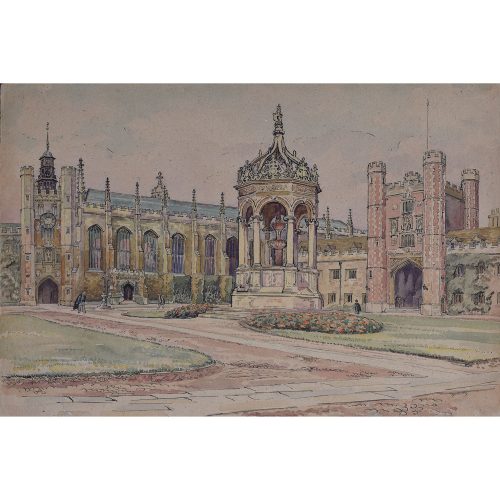
J V C Anthony
Great Court, Trinity College, Cambridge
Pen, ink and watercolour 37x56cm Latter half of twentieth century If you are interested email info@manningfineart.co.uk or call us on 07929 749056. -
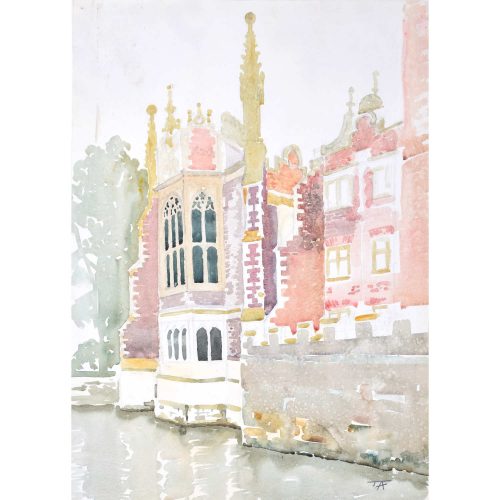
J V C Anthony (British, 20th Century)
St. John's College, Cambridge
Watercolour 55 x 37 cm (21.5 x 14.5 in.) Anthony exhibited with the Society of Marine Artists and painted a number of views of Cambridge. Click here to see other works by him. If you are interested email info@manningfineart.co.uk or call us on 07929 749056. -
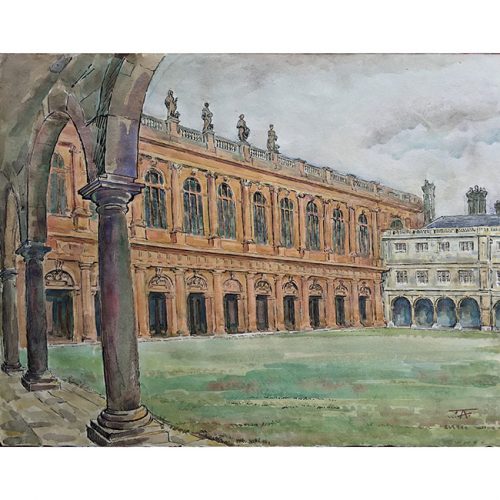
J V C Anthony
Wren Library, Trinity College, Cambridge
Watercolour and ink 39x49cm Anthony exhibited with the Society of Marine Artists and painted a number of views of Cambridge. Click here to see other works by him. If you are interested email info@manningfineart.co.uk or call us on 07929 749056. -
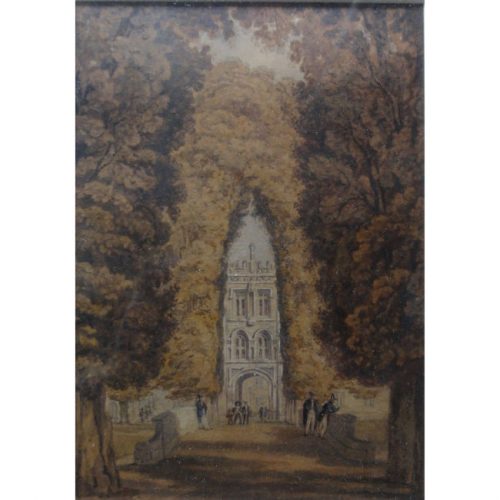
James Sargant Storer (1771–1853)
Trinity College Gateway from The Backs, Cambridge, c1820
Watercolour 19×13.5cm (7.4×5.3 inches) unframed This is the original watercolour for an engraving published as The Avenue by James & Henry Storer c.1820 in Delineations of Trinity College. The exquisitely detailed watercolour showing academical figures standing on Trinity Bridge as viewed from the backs is framed in its original nineteenth century gilt slip behind nineteenth century glass. Provenance: by decent from the artist. Storer was a topographer with an interest in ancient architecture, making drawings and engraving the plates himself. From 1814 he worked in conjunction with his eldest son, Henry, who predeceased him in 1837. They were buried next to each other at St James’s Chapel in Pentonville, now Joseph Grimaldi Park (named after the clown, Grimaldi who was buried there in 1837 and whose railed grave remains to this day). If you are interested email info@manningfineart.co.uk or call us on 07929 749056. -
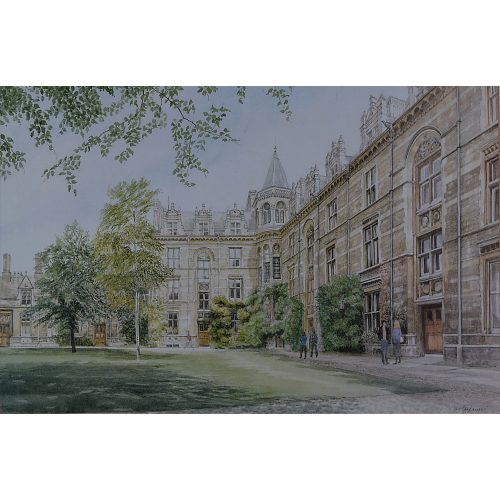
Jane Carpanini RWS RWA RCA (1949-) Gonville and Caius College, Cambridge
30x45cm Digital Limited Edition Print 77/350 Bornin Bedfordshire, Carpanini studied at Brighton College of Art and the University of Reading. Since the start of her career she has been known for meticulous architectural paintings. Wales has been a favourite subject and she has paintings in the collections of the National Library of Wales and National Museum of Wales. Her renowned series of views of Oxford and Cambridge Colleges were published by Contemporary Watercolours. If you are interested email info@manningfineart.co.uk or call us on 07929 749056. Condition: Excellent. -
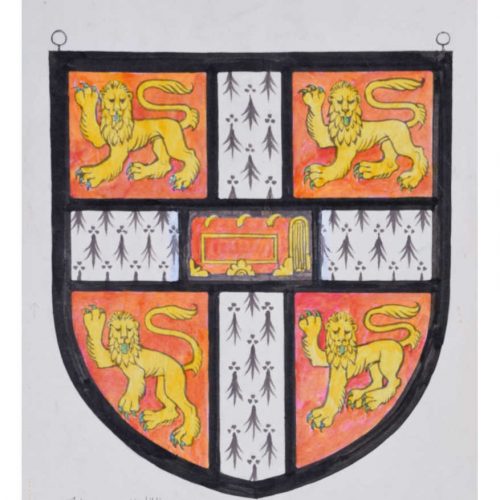
Jane Gray (b.1931)
Arms of University of Cambridge Design for Stained Glass Window
Watercolour 23 x 21 cm Detailed in artist's handThe University of Cambridge is one of the world’s oldest universities, with groups of scholars first congregating at the ancient Roman trading post of Cambridge for the purpose of study in 1209, the first college (Peterhouse) being founded in 1284. The university was granted its arms some years later in 1573 by Robert Cooke, Clarenceux King of Arms and a graduate of St. John's College. The granted arms are described in heraldic terminology, or blazon, as follows: Gules on a Cross Ermine between four Lions passant guardant Or a Bible fesswise Gules clasped and garnished Or the clasps in base.
Provenance: the artist’s studio sale. Condition: very good. If you are interested, please email info@manningfineart.co.uk or call us on 07929 749056. For other works by Jane Gray and more information about her, please click here. -

David Loggan (1634 - 1692)
Jesus College, Cambridge (1690)
Engraving 36 x 52 cm Loggan's skilful view of Jesus College from the 'Cantabrigia Illustrata'. Loggan was born to English and Scottish parents, and was baptised in Danzig in 1634. After studying engraving in Danzig with Willem Hondius (1598-1652 or 1658), he moved to London in the late 1650s, going on to produce the engraved title-page for the folio 1662 Book of Common Prayer. He married in 1663 and moved to Nuffield in Oxfordshire in 1665. Loggan was appointed Public Sculptor to the nearby University of Oxford in the late 1660s, having been commissioned to produce bird’s-eye views of all the Oxford colleges. He lived in Holywell Street as he did this. The 'Oxonia Illustrata' was published in 1675, with the help of Robert White (1645 - 1704). Following its completion, Loggan began work on his equivalent work for Cambridge; the 'Cantabrigia Illustrata' was finally published in 1690, when he was made engraver to Cambridge University. The 'Oxonia Illustrata' also includes an engraving of Winchester College (Winchester and New College share William of Wykeham as their founder) whilst the 'Cantabrigia Illustrata' includes one of Eton College (which shares its founder, Henry VIII, with King’s College). Bird’s-eye views from this era required a particular talent as an architectural perspectivist; it was not until 1783 that it became possible for artists to ascend via hot air balloons and view the scenes they were depicting from above. Loggan thus had to rely on his imagination in conceiving the views. Loggan’s views constitute the first accurate depictions of the two Universities, in many ways unchanged today. Whilst the Oxford engravings were produced in reasonable numbers and ran to a second edition by Henry Overton (on thicker paper and with a plate number in Roman numerals in the bottom right-hand corner), those of Cambridge were printed in much smaller numbers. The Dutchman Pieter van der Aa published some miniature versions of the engravings for James Beverell’s guidebook to the UK, 'Les Delices de la Grande Bretagne' (circa 1708). The contemporary artist Andrew Ingamells has produced a highly-acclaimed series of etchings which bring Loggan’s original vision up to date. Condition: extant portions very good; partly trimmed to within platemark; lacking portions of letters in lower left; also missing 1cm-width section down middle, historically replaced in pen and ink. Backed to laid paper. If you’d like to know more, please email info@manningfineart.co.uk or call us on 07929 749056. Click here for other views of Jesus College, Cambridge. -
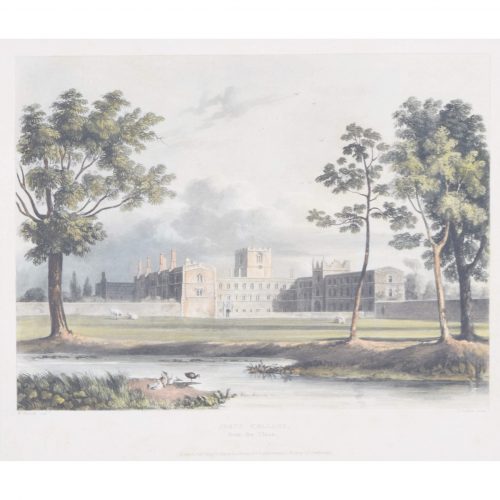
Joseph Constantine Stadler (1755 - 1828) after William Westall (1781 - 1850)
Jesus College, Cambridge, from the Close (1815)
Hand-coloured aquatint 24 x 29.5 cm Published by Rudolph Ackermann (1764 - 1834). An engraving of Jesus College, foregrounded by trees, the River Cam, and grazing cattle. Joseph Constantine Stadler was a prolific German émigré engraver of images after his contemporaries - here, 18th-century English landscape painter and diarist Joseph Farington. Stadler''s engravings are wide-ranging in subject matter and include landscapes, seascapes and portraits, as well as military, sporting and decorative subjects. Stadler was employed by the leading print publisher of the time, John Boydell. Stadler lived in Knightsbridge when he died at the age of 73. William Westall was a British landscape artist. He was born in Hertford and enrolled at the Royal Academy schools in 1799. He later became the draughtsman for a voyage to Australia and the South Seas. After being shipwrecked, he travelled to Canton in China and to India, staying in Bombay for several months. He returned to England in 1805 but later set off for Madeira and Jamaica. He became a member of the Society of Painters in Water Colours (1811) and an associate of the Academy (1812). Following a mental breakdown, he regularly visited the Lake District and published ‘Views of the Valley and Vale of Keswick’ (1820). His series of aquatints of the Thames, the great universities, and England's public schools for Ackermann are among his most popular works. Rudolph Ackermann was an Anglo-German bookseller, inventor, lithographer, publisher and businessman. In 1795 he established a print-shop and drawing-school at 96 Strand. Here Ackermann set up a lithographic press and began a trade in prints. He later began to manufacture colours and thick carton paper for landscape and miniature painters. Within three years the premises had become too small and he moved to 101 Strand, in his own words "four doors nearer to Somerset House", the seat of the Royal Academy of Arts. Between 1797 and 1800 Ackermann rapidly developed his print and book publishing business, encompassing many different genres including topography, caricature, portraits, transparencies and decorative prints. Condition: good. Some age toning. If you’d like to know more, please email info@manningfineart.co.uk or call us on 07929 749056. -
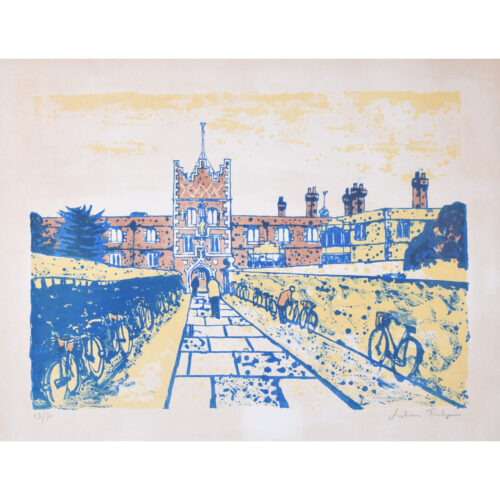
Julian Trevelyan (1910 - 1988)
Jesus College, Cambridge
Lithograph 38 x 53 cm Numbered 13/70 lower left and signed lower right, both in pencil. Nephew of the historian G M Trevelyan, Julian Trevelyan was educated at Bedales and then at Trinity College, Cambridge, where he read English. After moving to Paris, Trevelyan studied engraving at Stanley William Hayter’s school, working alongside artists such as Max Ernst, Joan Miro and Pablo Picasso. He married the potter Ursula Darwin in 1934, and in 1935 they moved to Hammersmith, buying Durham Wharf beside the River Thames which was Trevelyan’s studio – and home – for the rest of his life. His wartime service was – like so many artists – as a camoufleur. A Royal Engineer from 1940-43, he served in North Africa and Palestine, forcing the German Afrika Korps to use resources against a dummy army whilst real tanks were disguised as more harmless equipment. In the desert, nothing could be hidden - but it could be disguised. Following the dissolution of his marriage in 1950, he married the painter Mary Fedden. Teaching at Chelsea School of Art, Trevelyan eventually became head of the Etching Department and his pupils included David Hockney and Peter Ackroyd. Condition: generally very good; some age toning to paper. If you are interested, please email info@manningfineart.co.uk or call us on 07929 749056. Click here for other views of Jesus College, Cambridge. -
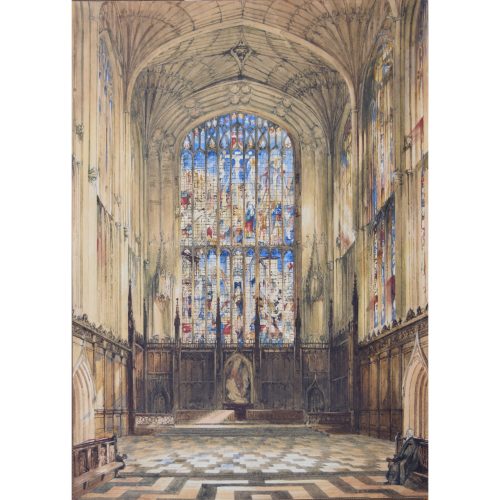
John Anderson Bell (1809-1865)
King's College Cambridge Chapel Interior
Signed and indistinctly dated Watercolour c. 1840 53x39cm Bell was born in Glasgow; his father was James Bell, advocate and his sister Jane Cross Simpson the hymn-writer and poet. Following Edinburgh University Bell spent 1829 and 1830 in Rome as an art student, returning to the UK to serve his articles as an architect with Rickman & Hutchinson, the gothic revivalist practice in Birmingham. Subsequently he practised in Edinburgh, designing country houses, and the Victoria Buildings in Glasgow for the Conservative politician Archibald Orr Ewing in Scottish baronial style. Thirty of the engravings in John Le Keux's magnificent 1847 book Memorials of Cambridge are from paintings by Bell; this particular painting is believed to have been painted at the same time, although not published. The Great East Window depicted in the painting was created between 1526 and 1531 by Gaylon Hone and three partners (one Flemish and two English) and - together with the other sixteen they made - represent some of the finest stained glass of their period. Here Bell has captured the colours and the light of the window in almost magical fashion. It is an interesting view as it records the chapel in the mid nineteenth century. In 1968 the installation of Rubens' the Adoration of the Magi as an altarpiece involved the lowering of the Sanctuary floor through removal of the steps clearly visible in Bell's view and also removal of the seventeenth century panelling around the walls. It is still felt that the chapel would have been better left 'unimproved' and without the Reubens, though the form recorded by Bell had itself been improved in 1906 when Detmar Blow designed a reredos. Blow's reredos remains in storage in the College. The East window may be viewed in high resolution in the series of seven short films - accompanied by music by King's alumnus Francis Grier - entitled Sword in the Soul. -
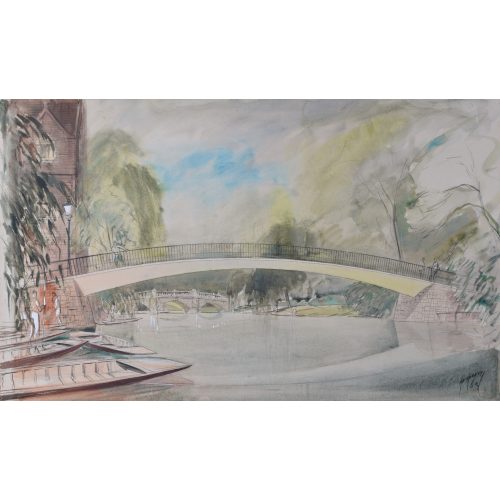
John Dean Monroe Harvey (1895-1978)
Garret Hostel Bridge, Cambridge, Trinity Hall and Clare College behind
38x61cm Watercolour and pencil For biographical details and more works by JDM Harvey, please click here. If you are interested email info@manningfineart.co.uk or call us on 07929 749056. -
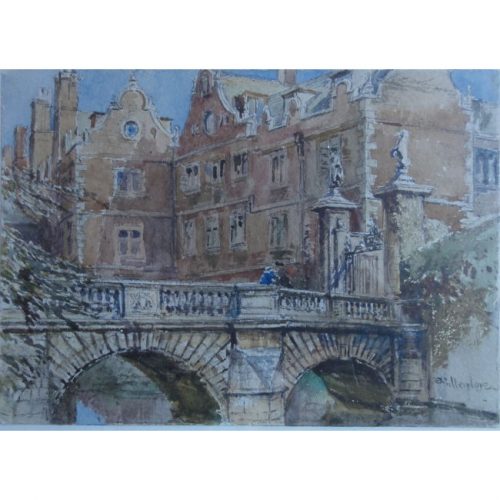 John Fulleylove (1845-1908) The Kitchen Bridge, St John’s College, Cambridge Signed lower right “Fulleylove” Watercolour 13 x 19cm (5 x 7 inches) Please click here for the matching watercolour of the Old Library together with biographical details and other works by the artist. If you are interested email info@manningfineart.co.uk or call us on 07929 749056.
John Fulleylove (1845-1908) The Kitchen Bridge, St John’s College, Cambridge Signed lower right “Fulleylove” Watercolour 13 x 19cm (5 x 7 inches) Please click here for the matching watercolour of the Old Library together with biographical details and other works by the artist. If you are interested email info@manningfineart.co.uk or call us on 07929 749056. -
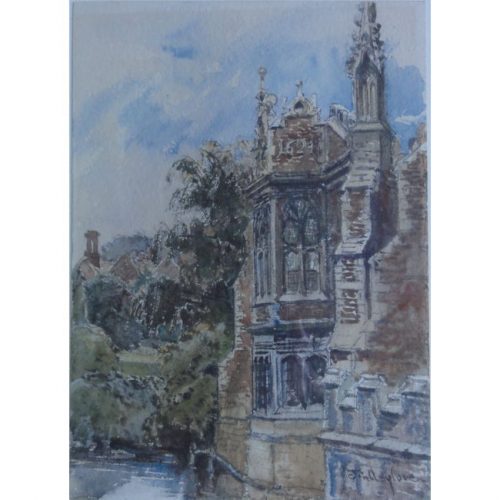
John Fulleylove (1845-1908)
The Old Library, St John’s College, Cambridge
Signed lower right “Fulleylove” Watercolour 19x13cm (7×5 inches) Please click here for the matching watercolour of the Kitchen Bridge together with biographical details and other works by the artist. If you are interested email info@manningfineart.co.uk or call us on 07929 749056. -
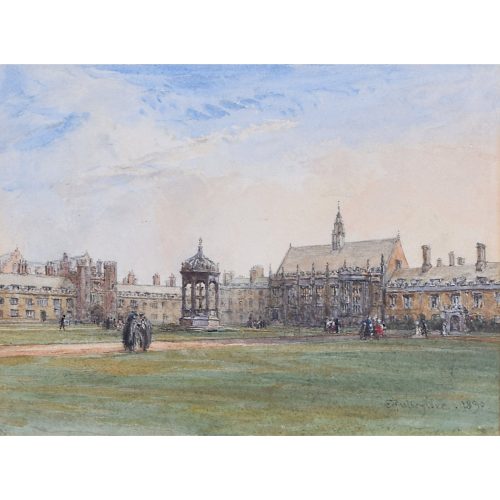
John Fulleylove (1845-1908) Trinity College, Cambridge - Great Court
Watercolour 13x17cm Born in Leicester, John Fulleylove trained as an architect with a Leicester firm before becoming a full-time painter. He exhibited widely in the UK, at such venues as the Royal Academy, the Fine Art Society, and the Royal Society of British Artists. His paintings were the subject of illustrated topographical books, including one on ‘Oxford’ published by the Fine Art Society. If you are interested email info@manningfineart.co.uk or call us on 07929 749056. Condition: Good. -

John Stanton Ward CBE (1917 - 2007)
St John's College, Cambridge
Watercolour 30 x 47 cm John Stanton Ward CBE was an English portrait artist, landscape painter and illustrator. This view of St John's highlights the dreamlike quality of the college and its city. Ward depicts Cambridge on a winter afternoon; the trees are bare, and the afternoon sun sets gently over the city's lawns and high spires. Condition: very good. -
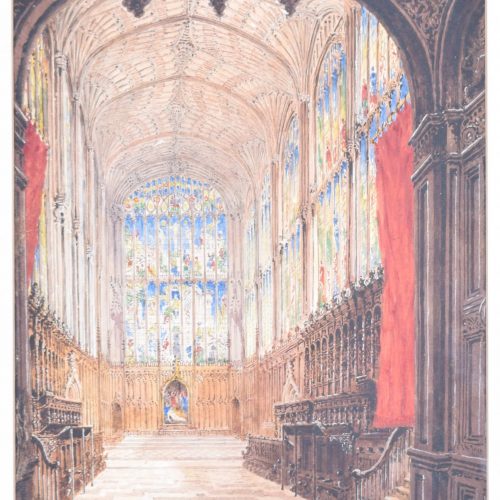
Joseph Murray Ince (1806-1859) King's College Chapel, Cambridge
Watercolour 27.5x21 In a fine hand-finished gilt frame. Provenance (label to reverse) Christopher Wood Gallery Signed lower right 'J M Ince 1844' Brought up in Radnorshire, in Wales, Ince studied under David Cox from 1823-1826, and then exhibited at the Royal Academy. He was a drawing master at Cambridge University during the 1830s, during which period he painted many views of the Colleges of both Oxford and Cambridge, returning to Radnorshire in 1835. His works are in the collections of major galleries including the Tate, The V&A and The Fitzwilliam Museum in Cambridge. This is a particularly fine interior painting of the venue for the famous annual Service of Nine Lessons and Carols. If you are interested email info@manningfineart.co.uk or call us on 07929 749056. Condition: In a fine hand-finished gilt frame. Generally very good condition. -
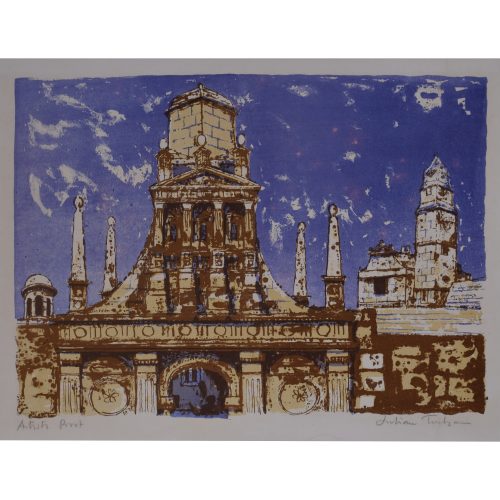
Julian Otto Trevelyan, RA (1910 -1988) Caius College II, Cambridge (1959/1962)
Signed by the artist and inscribed in pencil Artist's Proof, aside from the edition of 70. The edition consisted of 70 numbered proofs and 30 artist’s proofs. We also have listed one of the 70 numbered proof prints, which is in a purple colourway - rather than the blue here. 37x51cm (14.5×20 inches) This comes from Julian Trevelyan’s Cambridge Suite which consisted of 10 lithographs: Caius College, Caius College II, Christ’s College, Corpus Christi College, Downing College, Emmanuel College, Jesus College, Peterhouse, St Catharine’s College and Sidney Sussex College. The Government Art Collection has copies of several of the prints in this series. If you are interested email info@manningfineart.co.uk or call us on 07929 749056. Condition: Good. Old crease that runs from top to bottom has been restored and is barely perceptible - see photograph. -
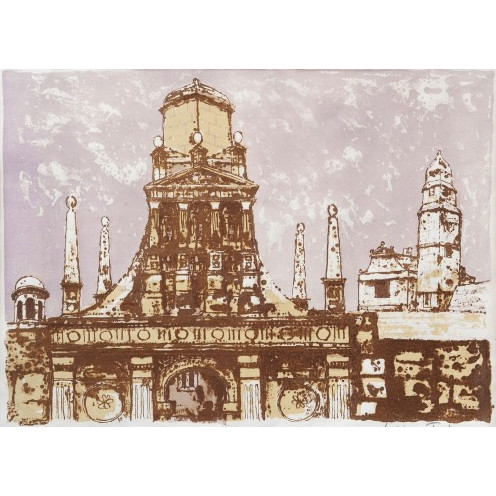
Julian Otto Trevelyan, RA (1910 -1988)
Caius College II, Cambridge (1959/1962)
Signed by the artist and numbered 4/70 in pencil. The edition consisted of 70 numbered proofs and 30 artist’s proofs. 37x51cm (14.5×20 inches) This comes from Julian Trevelyan’s Cambridge Suite which consisted of 10 lithographs: Caius College, Caius College II, Christ’s College, Corpus Christi College, Downing College, Emmanuel College, Jesus College, Peterhouse, St Catharine’s College and Sidney Sussex College. The Government Art Collection has copies of several of the prints in this series. Click here for biographical details and other works by the artist. If you are interested email info@manningfineart.co.uk or call us on 07929 749056. -
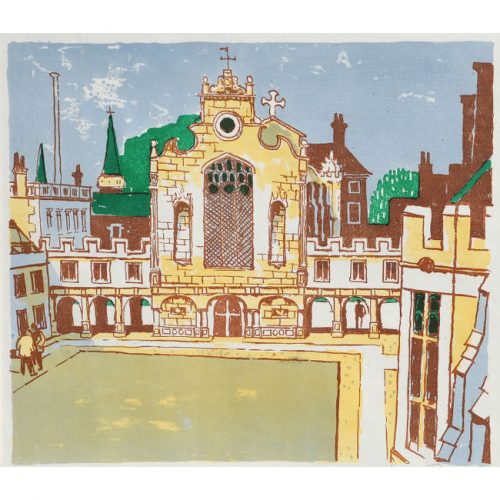
Julian Otto Trevelyan, RA (1910 -1988)
Peterhouse, Cambridge College (1959/1962)
Proof print aside from the edition of 70. Signed by the artist and numbered in pencil. 38 x 44 cm (15×17 in.) Framed This comes from Julian Trevelyan’s Cambridge Suite which consisted of 10 lithographs: Caius College, Caius College II, Christ’s College, Corpus Christi College, Downing College, Emmanuel College, Jesus College, Peterhouse, St Catharine’s College and Sidney Sussex College. The Government Art Collection has copies of several of the prints in this series. Click here for biographical details and other works by the artist. If you are interested email info@manningfineart.co.uk or call us on 07929 749056. -
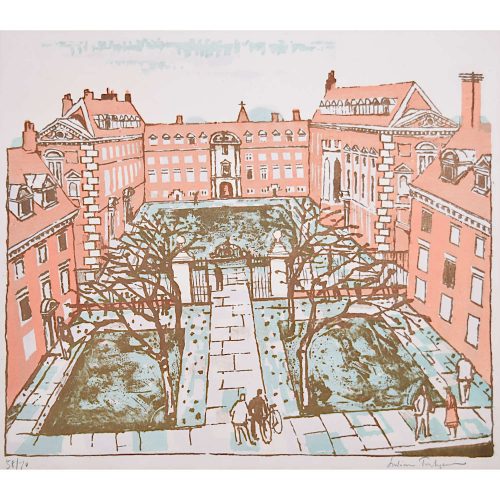
Julian Trevelyan (1910-1988) St Catharine's College, Cambridge
Etching and aquatint, signed, numbered 58/70 41 x 47 cm Nephew of the historian G M Trevelyan, Julian Trevelyan was educated at Bedales and then at Trinity College, Cambridge, where he read English. After moving to Paris, Trevelyan studied engraving at Stanley William Hayter’s school, working alongside artists such as Max Ernst, Joan Miro and Pablo Picasso. He married the potter Ursula Darwin in 1934, and in 1935 they moved to Hammersmith, buying Durham Wharf beside the River Thames which was Trevelyan’s studio – and home – for the rest of his life. His wartime service was – like so many artists – as a camoufleur. A Royal Engineer from 1940-43, he served in North Africa and Palestine, forcing the German Afrika Korps to use resources against a dummy army whilst real tanks were disguised as more harmless equipment. In the desert, nothing could be hidden - but it could be disguised. Following the dissolution of his marriage in 1950, he married the painter Mary Fedden. Teaching at Chelsea School of Art, Trevelyan eventually became head of the Etching Department and his pupils included David Hockney and Peter Ackroyd. Condition: Some toning to paper. If you’d like to know more, please email info@manningfineart.co.uk or call us on 07929 749056. -
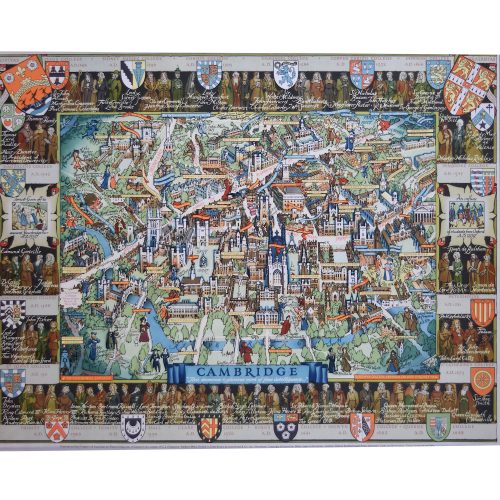
Kerry Lee (1903-1988)
'Cambridge' Original Poster Map c. 1965
45x58cm Original Vintage Lithographic poster Published by Pictorial Maps Limited, Kerry Lee's own company The first edition of this map was 1947; this is a later edition showing as it does Fitzwilliam College in its new location on the Huntingdon Road where it moved in 1963, but still referring to it as Fitzwilliam House - it became a college in 1966. Well known as a creator of pictorial maps of British cities from the mid 20th century, he generally draws a self-portrait in the bottom corner by his signature - as here, where he is seen (mustachioed and bearded, and clad in a green tunic) with his ever-faithful dog Jim. Educated at Reading Schools of Arts and Science, the Slade and the Sorbonne in Paris, he subsequently assisted his step-father, an architect named Mr Harvey, as draftsman. Following the Depression Lee set up 'Associated Artists' at Blandford Studios off Baker Street, with a group of other commercial artists. During World War 2 he was based in Hertfordshire creating detailed cut-away drawings of German aircraft, and after the war - still at Blandford Studios - published a series of pictorial maps, both those for British Rail and also his own publications. -
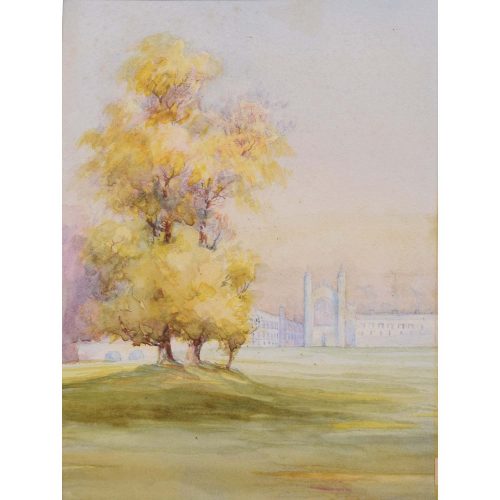
King’s College Cambridge from The Backs
Watercolour 24×16.5cm If you are interested email info@manningfineart.co.ukor call us on 07929 749056. -
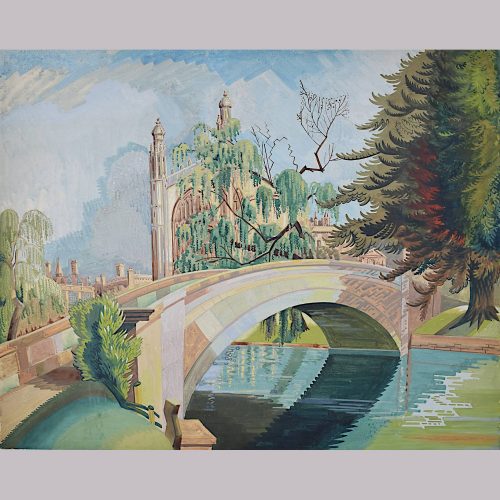
Anonymous King's College Cambridge with the River Cam and Bridge to foreground
51x63.5cm Watercolour Probably 1920s A fine, and large, view of King's College. The artist paints in an art deco style, picking out the stones of the bridge in different colours, the colours all having a heightened sense of reality. Born from cubism, the art deco era is characterised by a fragmented, geometric character particularly evident here. It gives the impression of a shimmering dream. The twenties was an incredible period of change, moving from heavy elaborate styles to a pared back and sleek style expressing more dynamism, an interest in dimension and abstraction. If you are interested email info@manningfineart.co.uk or call us on 07929 749056.

